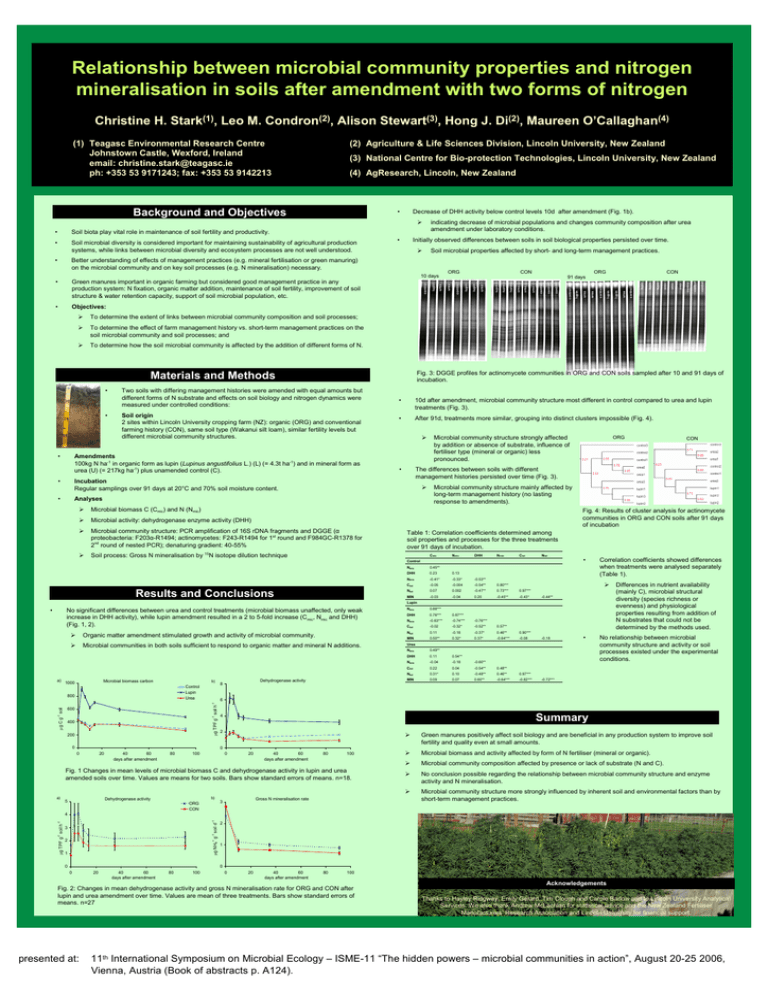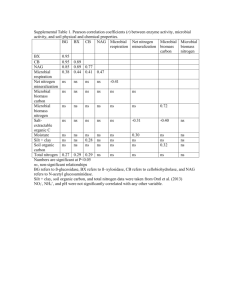Relationship between microbial community properties and nitrogen
advertisement

Relationship between microbial community properties and nitrogen mineralisation in soils after amendment with two forms of nitrogen Christine H. Stark(1), Leo M. Condron(2), Alison Stewart(3), Hong J. Di(2), Maureen O’Callaghan(4) (1) Teagasc Environmental Research Centre Johnstown Castle, Wexford, Ireland email: christine.stark@teagasc.ie ph: +353 53 9171243; fax: +353 53 9142213 (2) Agriculture & Life Sciences Division, Lincoln University, New Zealand (3) National Centre for Bio-protection Technologies, Lincoln University, New Zealand (4) AgResearch, Lincoln, New Zealand Background and Objectives • Decrease of DHH activity below control levels 10d after amendment (Fig. 1b). ¾ • Soil biota play vital role in maintenance of soil fertility and productivity. • Soil microbial diversity is considered important for maintaining sustainability of agricultural production systems, while links between microbial diversity and ecosystem processes are not well understood. • Better understanding of effects of management practices (e.g. mineral fertilisation or green manuring) on the microbial community and on key soil processes (e.g. N mineralisation) necessary. • Green manures important in organic farming but considered good management practice in any production system: N fixation, organic matter addition, maintenance of soil fertility, improvement of soil structure & water retention capacity, support of soil microbial population, etc. • Objectives: ¾ To determine the extent of links between microbial community composition and soil processes; ¾ To determine the effect of farm management history vs. short-term management practices on the soil microbial community and soil processes; and ¾ To determine how the soil microbial community is affected by the addition of different forms of N. • indicating decrease of microbial populations and changes community composition after urea amendment under laboratory conditions. Initially observed differences between soils in soil biological properties persisted over time. ¾ Soil microbial properties affected by short- and long-term management practices. 10 days Materials and Methods ORG CON 91 days ORG Fig. 3: DGGE profiles for actinomycete communities in ORG and CON soils sampled after 10 and 91 days of incubation. • Two soils with differing management histories were amended with equal amounts but different forms of N substrate and effects on soil biology and nitrogen dynamics were measured under controlled conditions: • Soil origin 2 sites within Lincoln University cropping farm (NZ): organic (ORG) and conventional farming history (CON), same soil type (Wakanui silt loam), similar fertility levels but different microbial community structures. • Amendments 100kg N ha-1 in organic form as lupin (Lupinus angustifolius L.) (L) (= 4.3t ha-1) and in mineral form as urea (U) (= 217kg ha-1) plus unamended control (C). • Incubation Regular samplings over 91 days at 20°C and 70% soil moisture content. • Analyses • 10d after amendment, microbial community structure most different in control compared to urea and lupin treatments (Fig. 3). • After 91d, treatments more similar, grouping into distinct clusters impossible (Fig. 4). ¾ • ¾ Microbial biomass C (Cmic) and N (Nmic) Microbial activity: dehydrogenase enzyme activity (DHH) ¾ Microbial community structure: PCR amplification of 16S rDNA fragments and DGGE (α proteobacteria: F203α-R1494; actinomycetes: F243-R1494 for 1st round and F984GC-R1378 for 2nd round of nested PCR); denaturing gradient: 40-55% ¾ Soil process: Gross N mineralisation by 15N isotope dilution technique Fig. 4: Results of cluster analysis for actinomycete communities in ORG and CON soils after 91 days of incubation Table 1: Correlation coefficients determined among soil properties and processes for the three treatments over 91 days of incubation. Nmic 0.45** Nmic DHH Nmin Ctot Ntot DHH 0.23 • 0.13 Nmin -0.41* Ctot -0.05 -0.004 -0.54** 0.80*** Ntot 0.07 0.002 -0.47** 0.73*** 0.97*** MIN -0.03 -0.33* -0.04 0.20 -0.53** -0.45** -0.43* Correlation coefficients showed differences when treatments were analysed separately (Table 1). ¾ -0.44** Lupin No significant differences between urea and control treatments (microbial biomass unaffected, only weak increase in DHH activity), while lupin amendment resulted in a 2 to 5-fold increase (Cmic, Nmic and DHH) (Fig. 1, 2). a) Nmic 0.76*** Nmin -0.63*** Ctot -0.02 -0.32* -0.52** 0.57** 0.11 -0.18 -0.37* 0.46** 0.90*** MIN 0.50** 0.32* 0.37* -0.64*** -0.08 ¾ Organic matter amendment stimulated growth and activity of microbial community. ¾ Microbial communities in both soils sufficient to respond to organic matter and mineral N additions. Urea 1000 b) Control Lupin Urea 8 Nmic 0.87*** -0.74*** -0.76*** -0.18 • 0.49** DHH 0.11 Nmin -0.04 Ctot 0.22 0.54** 0.04 -0.54** Ntot 0.31* 0.10 -0.48** 0.46** 0.97*** MIN 0.09 0.07 0.60** -0.64*** -0.82*** -0.18 -0.60** Differences in nutrient availability (mainly C), microbial structural diversity (species richness or evenness) and physiological properties resulting from addition of N substrates that could not be determined by the methods used. No relationship between microbial community structure and activity or soil processes existed under the experimental conditions. 0.48** -0.72*** 6 μg TPF g soil h 600 -1 -1 μg C g soil -1 800 Dehydrogenase activity 0.88*** DHH Ntot Microbial biomass carbon CON Microbial community structure mainly affected by long-term management history (no lasting response to amendments). Cmic Results and Conclusions ORG The differences between soils with different management histories persisted over time (Fig. 3). ¾ ¾ Microbial community structure strongly affected by addition or absence of substrate, influence of fertiliser type (mineral or organic) less pronounced. Control • CON 400 200 0 Summary 4 2 0 0 20 40 60 days after amendment 80 100 0 20 40 60 days after amendment 80 100 Fig. 1 Changes in mean levels of microbial biomass C and dehydrogenase activity in lupin and urea amended soils over time. Values are means for two soils. Bars show standard errors of means. n=18. a) b) Dehydrogenase activity 5 ORG CON Gross N mineralisation rate 3 ¾ Green manures positively affect soil biology and are beneficial in any production system to improve soil fertility and quality even at small amounts. ¾ Microbial biomass and activity affected by form of N fertiliser (mineral or organic). ¾ Microbial community composition affected by presence or lack of substrate (N and C). ¾ No conclusion possible regarding the relationship between microbial community structure and enzyme activity and N mineralisation. ¾ Microbial community structure more strongly influenced by inherent soil and environmental factors than by short-term management practices. μg NH4 g soil d 2 -1 3 -1 μg TPF g soil h -1 -1 4 + 2 1 1 0 0 0 20 40 60 days after amendment 80 100 0 20 40 60 days after amendment 80 100 Fig. 2: Changes in mean dehydrogenase activity and gross N mineralisation rate for ORG and CON after lupin and urea amendment over time. Values are mean of three treatments. Bars show standard errors of means. n=27 presented at: Acknowledgements Thanks to Hayley Ridgway, Emily Gerard, Tim Clough and Carole Barlow and to Lincoln University Analytical Services. We also thank Andrew McLachlan for statistical advice and the New Zealand Fertiliser Manufacturers’ Research Association and Lincoln University for financial support. 11th International Symposium on Microbial Ecology – ISME-11 “The hidden powers – microbial communities in action”, August 20-25 2006, Vienna, Austria (Book of abstracts p. A124).





